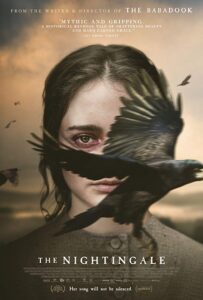Emotionally gut-wrenching and difficult, Jennifer Kent’s followup to “The Babadook” is an important film.


The somewhat negative grumble about “The Nightingale” should be discounted. Some have bemoaned the graphic handling of rape and violence against women, wondering whether our critical acceptance of such depictions are related to the fact that the film is written and directed by a woman. My feeling is that this brutal piece of cinema is utterly authentic, and the perspective of its filmmaker helps to set it apart, floating in the shark-infested sea of lesser films that have exploited rape as a special effect.

Photo by Matt Nettheim
It’s 1825, in a British penal colony in Tasmania, 21-year-old Clare (Aisling Franciosi) is counting the days until she is given her freedom. The Irish convict has served the colony and the desires of officer Hawkins (Sam Claflin) without incident, and now, looks forward to the release that she’s earned. But when her husband becomes aware of Hawkins’ liberties with Clare, he seeks justice, in a place and time where his kind have no voice. After a terrible sequence of tragic events, Clare takes up a journey for justice, as well. What Clare and her Aboriginal guide Billy (Baykali Ganambarr) find in the outback is a special kind of retribution that will never make anything right.
“The Nightingale” is raw. Its unyielding forward progress is unrelenting and rather dour. It’s true, so true to the story that, I think, Kent wants to convey. And the graphic violence thrusts home inhumanity like few films of recent vintage. Unlike the whimsy that helped soften, for the tender-hearted, her brilliant horror film “The Babadook,” this movie never lets you forget the real horror of that time, that place, and what it meant to be considered a lesser sort of being, wrongfully based upon one’s gender, nationality, or race.

Photo by Matt Nettheim
Aisling Franciosi, who played the older Lyanna Stark in HBO’s “Game of Thrones,” is impressive as Clare. Her character’s single-minded campaign requires Franciosi to be hard when it matters, and to break down when it’s impossible not to. The role also requires her to sing an Irish ballad, which she does quite well, showing her versatility.
Along side Franciosi is Baykali Ganambarr in, literally, his first on-screen appearance, according to IMDB. Ganambarr is pretty amazing here. As Billy, his character evolves on screen along with Clare, as the two deal with unspeakable events. And the instrument of much of their torment is Hawkins, played by the normally very likable and handsome Sam Claflin. All three leads are well-cast.

Photo by Matt Nettheim
The film is shot and presented in the 1.37:1 aspect ratio, often referred to as Academy. This is becoming more and more common as auteurs seek to narrow the field of view to suit their particular point of view. However, I wonder if this decision makes the visuals seem more intimate and personal, or does it distract from the grandness of the outback environments (albeit most of the scenes are shot in heavily wooded forests or jungle)? I’d like to hear from readers with their thoughts on the aspect ratio changes that are currently en vogue.
Kent’s display of sexual violence and the aftermath give us a unique view. “The Nightingale” is anything, if not provocative, which should further the necessary conversation.
